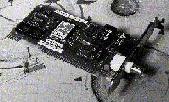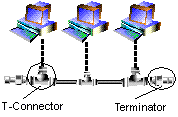OS/2 Tips: How to build a home network with OS/2 Warp Connect
| Article Info | |
|---|---|
| Author | Kevin Royalty, Chris Lloyd |
| Date | |
| OS Version | |
| Companion File | N/A |
| Source | |
Note: This article originally was published in May of 1995, with some minor changes to bring it up to date.
If you have two or more computers at home, and are using OS/2 Warp Connect on one machine, and wish to have your own network, then read on! This document will guide you through the basics of one scenario on how to get both machines working together, including the hardware necessary.
Step 1: Obtain OS/2 Warp Connect.
You can, if you are already using OS/2 Warp (any version), upgrade to Warp Connect for about $85 (after rebate). If you are using OS/2 2.1/2.11/for Windows you can upgrade to Warp Connect for about $159. As always - check around for the best price (don't forget Indelible Blue if you can't find it locally).
Step 2: Obtain Network Cards and assorted connecting hardware.
[For a nice How-To on networking, check the Linksys How to Build a Network Guide]

For this example, we obtained the Linksys Ether16 Combo LAN Cards locally from Computer City for $45 each (CompUSA sells them for around $39 as of 6/15/96).

It has both BNC (thin coaxial like cable TV) and RJ45 (like a phone connector) connectors. We will use the BNC connectors. The Linksys cards come with a "T" connector, which you do need. You will also need two BNC Male Terminators, for thin ethernet, 50 OHM. We chose the Belkin Networking Products part number R6C043-E-2 for about $5.99 from CompUSA.
The cabling is the last part, and this depends on the distance between the computers. For our tests, we chose a 10' length, also from Belkin Networking Products, for about $10. We also obtained a 50' length as well. This cost about $18. Cabling prices vary greatly, and if you are interested in building your own cables, you should review the networking guide listed at the beginning of this step.
Step 3: Obtain any updated drivers for the network cards (if necessary).
We checked the date of the files on the disk, and they were the current version when we compared the files to the ones on the website for Linksys. We found the OS/2 drivers in the \NDIS\OS2 directory on the diskette.
If you purchased a card, the documentation or a README file on the diskette should give you a BBS phone number or WWW/FTP site to obtain updated device drivers.
Step 4: Configure the Card.
Set any jumpers on the card that you may need. Most cards nowadays don't have jumpers anymore, but are set in software. You may need to wait until the card is installed to set the configuration.
Network cards DO use an IRQ address, and a memory address, so find one that is free. RMVIEW /IRQ can help you in this matter from an OS/2 Prompt. You should do this BEFORE the card is installed.
Step 5: Install the Card
If you are not comfortable rummaging around inside your machine, find someone else in the users group that you can entice to help you install the card.
Once the card is installed, close up the machine and power it up.
If you need to set the card up via a setup program, do it now.

Connect your network up like this example picture (your number of machines may vary), ensuring that the endmost computers have the terminators attached.
Step 6: Install OS/2 Warp Connect.
There are two ways to install Warp Connect.
If you already have OS/2 Warp Installed, insert the CD-ROM, insert the disks as if you were wanting to install again. It will recognize that Warp is already installed and ask if you want to install networking support. Say yes, and skip the next sentence.
If you need to install OS/2 Warp Connect, insert the Disks and CD-ROM and follow the normal procedures.
Step 7: Configuring OS/2 Warp Connect's Peer Services.
When you get to the Network Installation screen, here is what you will need to do:
- Screen: "Local Vs Remote".
Since we want to install on this machine, chose "On this workstation" and click OK. If you are installing over existing Warp, you might not see this screen. Skip to the next one below.
- Screen: "Installing OS/2 Warp Connect".
Chose Advanced Installation. Click OK.
- Screen: "Product Selection"
Here is where you need to decide what kind of networking to install. We are going to install OS/2 Peer, so select "IBM Client Products" and "IBM Peer for OS/2". If you intend to run any network software that needs Novel IPX/SPX support (like DOOM, Heretic, Descent, or other non-entertainment software), chose "Novell Netware Client 2.11 for OS/2". (We will not cover TCP/IP installation here, or LAN Distance.) Click OK.
- Screen: "Set Up Selected Products"
This screen will attempt to select the network card you have in your machine. Since, in our example, the Linksys card isn't listed, we click on "Other Adapter" and insert the floppy disk with the drivers, or point to a subdirectory on the hard drive with the updated drivers for Warp Connect.
- You might also need to set the same addresses for the driver in OS/2 Warp Connect that you did when setting up the card.
- For the Linksys Ether16 Combo LAN Card, leave the Network Adapter Address blank, and the other settings at their defaults. Click OK.
- Click on the OS/2 Peer notebook tab.
- Give your machine a name. Our machines were named "Kevin_PC" and "Chris_PC". Type this into the Workstation Name field.
- Give your machine a description. This is freeform, fill it in.
- The Domain Name is IBMPEERS by default. Since we are hooking two OS/2 Warp Connect machines together, we will leave this blank. If you were connecting to a Windows for Workgroups, then you would change this to WORKGROUP. We are not covering that in this example.
- The Protocol should be NetBios.
- There is no selections for Netware Requester, other than the drive to install the software onto, so we ignore this.
- Click Install and let Connect do the work.
Step 8: After the install...
Now that you are finished the installation, here is a bit of information for you:
If you installed the Netware Requester support, you will get an error message box on boot that says "Error! REQ0815: The program cannot get the connection ID" - this is because we do not have a Netware Server available on our home network. We can still use IPX/SPX software over the Peer network however. Click OK to make this go away.
Step 9: Setting up the Administrative User.
You will need to enter a user id and password the first time you boot your PC with the Peer Services. The password is optional, and if you wish for the machine to automatically log on when it boots up, simply add the line "LOGIN {userid}" to the STARTUP.CMD file located in the root directory of your OS/2 boot drive.
For Further Information:
An excellent book covering OS/2 Warp Connect is available. Further details are available in the book: OS/2 Warp Administrators' Survival Guide.